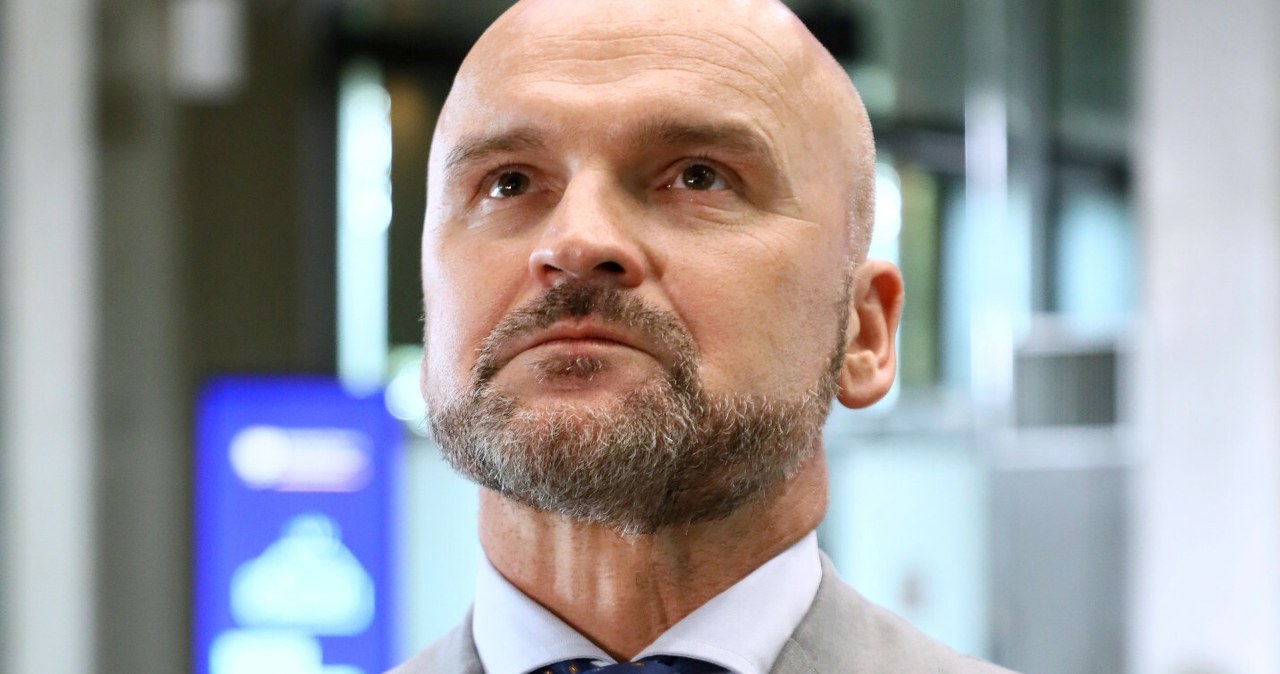| Robert W Malone MD, MSMay 4 · Malone News |
| This is a must-read for those interested in the topics of Dr. Fauci and gain-of-function research. Speculation about the author includes Dr. Jeffrey Taubenberger. The question now is whether or not DNI Tulsi Gabbard is serious about calling out Fauci’s perjury before Congress, and whether the autopen blanket pardon is valid. I strongly suspect that the pardon relates to much more than just the WIV GOF. Fauci probably knew what was happening in the Ukraine biolabs and much more. |
NIH Infectious Disease Researcher Calls for End of Dangerous Virus Studies
“I admired Fauci in his earlier career because I thought he was a strong leader with a vision for global research. But I can’t say that anymore.”
| MAY 4 |
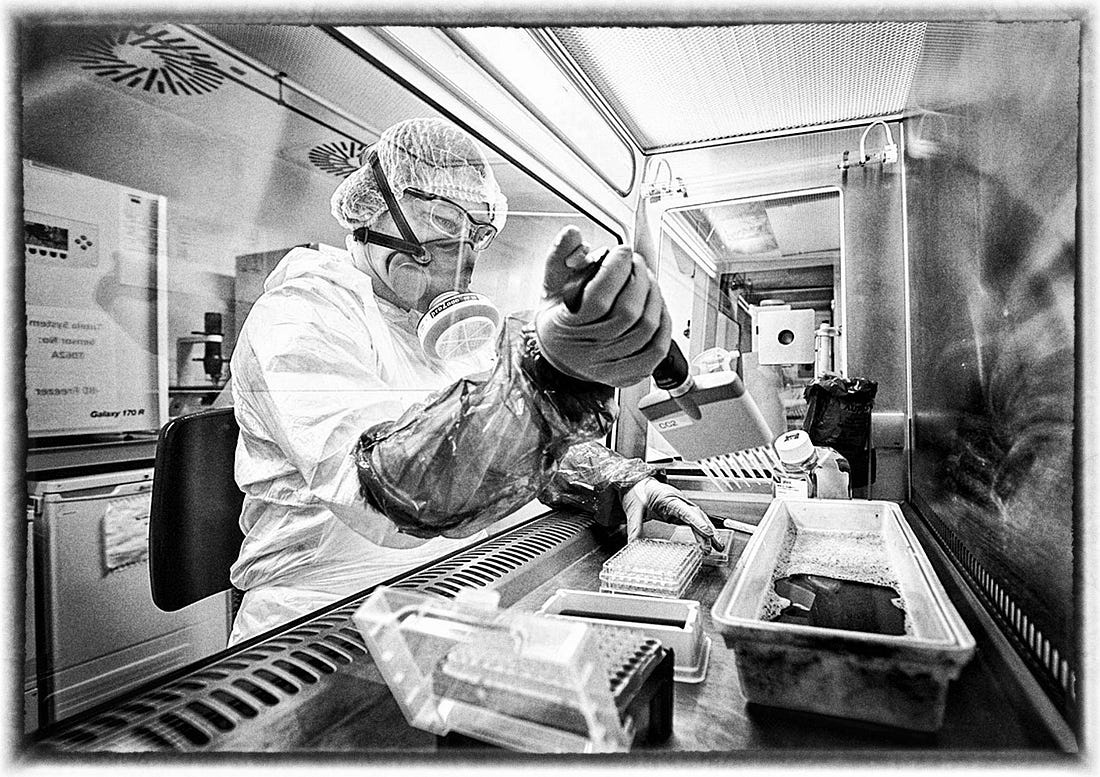
Today’s guest essay is by a infectious disease researcher at the National institutes of Health who wishes to remain anonymous to guard against retribution.
As a decades-long NIH insider, I wasn’t surprised to see Dr. Tony Fauci go toe-to-toe with President Trump in his first term. After all, this is a man who built a $4 billion taxpayer-funded empire—the National Institute of Allergy and Infectious Diseases (NIAID)—and transformed it into a medieval Italian Signoria, where his every word was law, his every whim obeyed. When I entered his office, I couldn’t help but notice a portrait of The Godfather hung above his desk—Marlon Brando as Don Vito Corleone, not Al Pacino as the young, upstart Michael—a fitting tribute to his persona and leadership style.
Upon entering NIH meetings, I sometimes caught a favored capo slouching down in his chair after dutifully raising Fauci’s own, so that, feet dangling, the diminutive Don would appear the tallest man in the room. From such commanding heights, the Boss often humiliated staff members, both women and men, in expletive-laden tirades. To avoid this wrath, his minions worked feverishly to anticipate his every desire and satisfy a relentless ambition to expand the Fauci’s scientific dominion.
I admired Fauci in his earlier career because I thought he was a strong leader with a vision for global research. But I can’t say that anymore.
Several incidents caused me to change my view beginning in March 2020 when a group of renowned virologists published a paper in Nature Medicinethat falsely concluded a lab accident could not have started the COVID pandemic. A year later, I watched in disbelief as Dr. Fauci testified before Congress where he strongly denied allegations about dangerous virus research he was funding at the Wuhan Institute of Virology. I realized that the Fauci-led NIAID had participated in a classic Washington ploy: satisfy your critics by pretending to regulate activity that can harm the public, while actually letting your friends do whatever they want. In this case, I’m talking about gain-of-function virus studies, research that should end tomorrow to protect us from future man-made pandemic disasters.
Pandemic Subterfuge
Like most everyone in the federal government, in the early months of the pandemic I was working from home when Nature Medicine published a paper called “The proximal origin of SARS-CoV-2.” Written by prestigious virologists Scripps researcher Kristian Andersen and Tulane University’s Robert Garry, this paper concluded, “We do not believe that any type of laboratory-based scenario is plausible.” The paper analyzed the genetic sequence of the COVID virus and concluded that SARS-CoV-2 was a naturally occurring virus, as no clear signs of “gain-of-function” were detected.
Gain-of-function is a process where virologists manipulate a virus’s genetic sequence to make it more transmissible, lethal, or able to overcome countermeasures. After making a virus more dangerous through gain-of-function, researchers then try to figure out how to defeat it. However, the “Proximal Origin” letter in Nature Medicine overlooked a common gain of function method.
Virologists often use a technique called “serial passaging,” where a virus is repeatedly introduced to laboratory animals or different cell types, such as human cell lines. Repetitive passaging allows the virus to genetically adapt, enabling it to grow in the new animal or cells. And such passaging does not require direct genetic manipulation.
The authors of the “Proximal Origin” paper completely ignored the possibility of serial passaging. And because they didn’t discuss this very common laboratory practice, they did not “disprove” a laboratory origin for the virus. I have no idea how ignoring something so obvious could make it pass peer review and get published in a prestigious journal like Nature Medicine.
I remember sitting in my living room, carefully reading the paper line by line, and shouting over to my partner in the next room, “What the fuck is going on?!”
Despite such a gaping hole in the analysis, the paper was taken as gospel by basically every reporter covering it—New York Times, CNN, Science Magazine, NBC, Science News, Nature Magazine, Washington Post, etc…—as if it ended all doubt that the COVID virus could have come from a lab.
I discussed this quietly with a few close colleagues I consider friends, but I’m embarrassed to admit that I was afraid to speak out publicly. At the time, people were being called “conspiracy theorists” for even asking if the virus could have had a lab origin. There was a real fear of saying what you thought—shame, humiliation—and I was worried about getting fired. I believed the entire virology and the NIH-funded scientific communities would have banded together to discredit me if I said anything, and my career would have been over. Dr. Fauci was the most powerful man in the scientific community at that time and his word was undisputed.
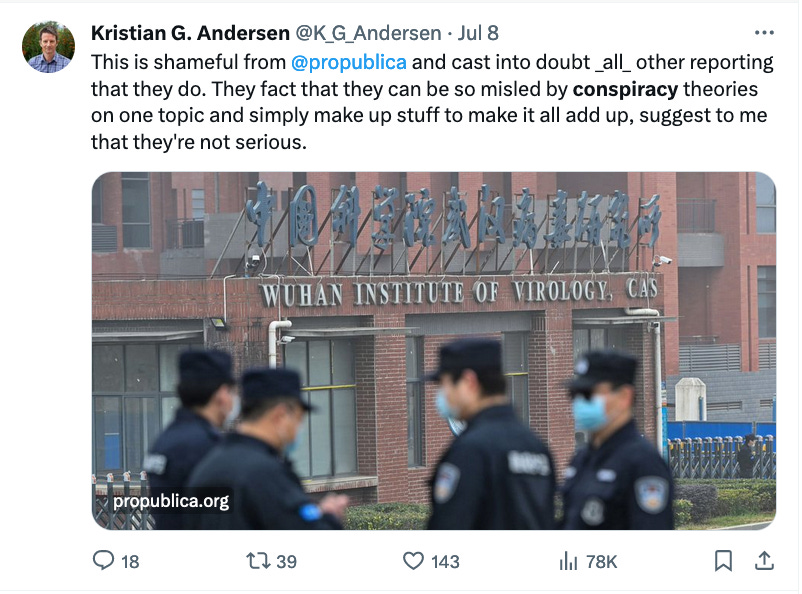
Besides, the toxic political climate at the NIH did not allow much for dissenting opinions. All communications by federal employees are vetted and go through a multi-layered review process, and criticism of the official narrative would never have been allowed. As any member of the NIH knew, you don’t ever take sides against the family.
The authors of the “Proximal Origin” paper completely ignored the possibility of serial passaging.
During this same time period, I also became aware that something weird was happening inside the NIH. In April 2020, Trump cut off a grant to Peter Daszak who ran a nonprofit called EcoHealth Alliance. Daszak was partnering with researchers at the Wuhan Institute of Virology to collect and characterize bat coronaviruses in China. Trump’s executive action was an effort to prevent another possible COVID-19-like pandemic, even though Politico called these concerns a “conspiracy theory.” But rather than reassess the risks of this research, as the President wanted, the Fauci-led NIAID doubled down on high-risk viral research, funding new programs called Centers for Emerging Infectious Diseases (CREID). These research programs focused entirely on global collection and surveillance of zoonotic viruses from nature.
Instead of pausing to investigate whether a lab leak had occurred, Fauci awarded Daszak a new multi-million-dollar CREID grant dedicated to hunting for novel viruses in bats—not just in Chinese caves, but across Southeast Asia and parts of Africa. From 2020 to the present, Daszak and EcoHealth Alliance received $4,474,707 for his CREID grant plus another $3,353,628 for similar virus hunting grants.
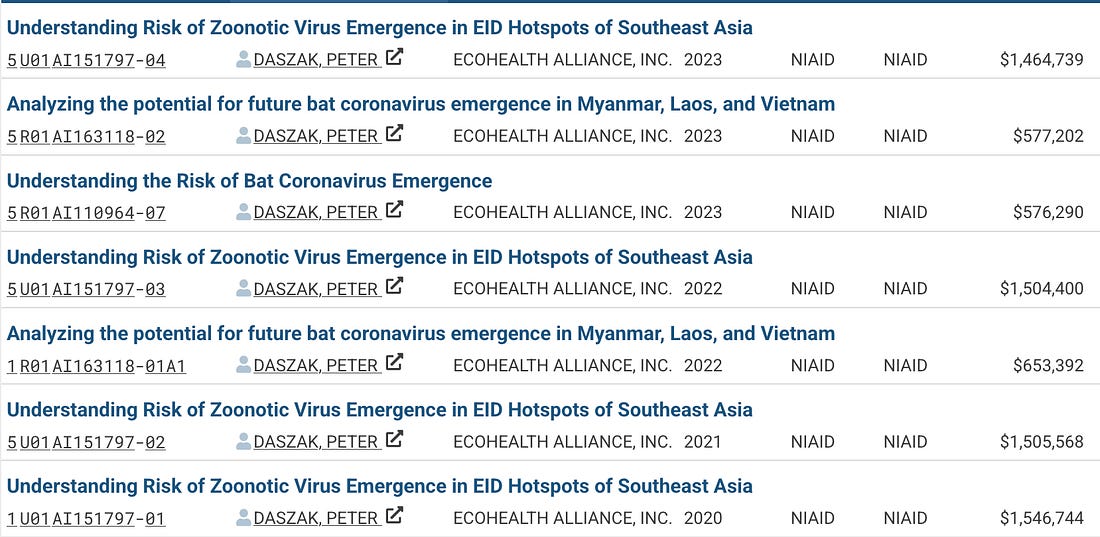
At the same time, NIAID also awarded the authors of the Proximal Origin paper—Scripp’s Andersen and Tulane’s Garry—large CREID grants which have cost American taxpayers $11,322,650. By handing out awards to political allies, Don Fauci maintained a web of allegiances.
But these grants were a slap in the face to President Trump and completely dismissed the American public whose family members were dying from a pandemic which could have started from NIH-funded virus research. The timeline of these awards is also interesting. Andersen’s CREID grant had been reviewed in November 2019 and presented to the official NIAID Advisory Council in January 2020. Fauci would have known the names of researchers getting such a massive grant, and Andersen and Garry would have been very eager to please Fauci.
By publishing the “Proximal Origin” paper, both Andersen and Garry gave Fauci a handy talking point to misdirect public attention away from a lab accident in a Wuhan lab that he was funding. Dr. Collins promoted Andersen’s “Proximal Origin” paper in his March 2020 NIH Director’s Blog, and Fauci seized upon the paper during a televised White House briefing.
Fauci cast aside the possibility of a laboratory-based origin by citing the “Proximal Origin” paper in an April 17, 2020 White House Coronavirus Task Force press briefing. When asked whether the virus was possibly manmade in a lab in China, President Trump stepped aside from the podium and let Fauci answer:
There was a study recently that we can make available to you, where a group of highly qualified evolutionary virologists look at the sequences there and the sequences in bats as they evolve and the mutations that it took to get to the point where it is now is totally consistent with a jump of species from an animal to a human. So, the paper will be available. I don’t have the authors right now, but we can make that available to you.
Fauci’s remarks, as he stood next to the President, really gave the paper added media and public value. At the time, I thought it was weird that Fauci would promote researchers who ignored the obvious possibility of serial passaging, but we later learned that Fauci was intimately involved in the “Proximal Origin” paper.
Emails showed that Andersen sent Fauci several updates as the paper was being written, and even invited him to make suggestions. In a sworn congressional deposition, Fauci later admitted to receiving 5 to 10 drafts of the paper but claimed he didn’t really understand it. But if he really didn’t understand the paper, then why did he promote it to reporters at a White House briefing?
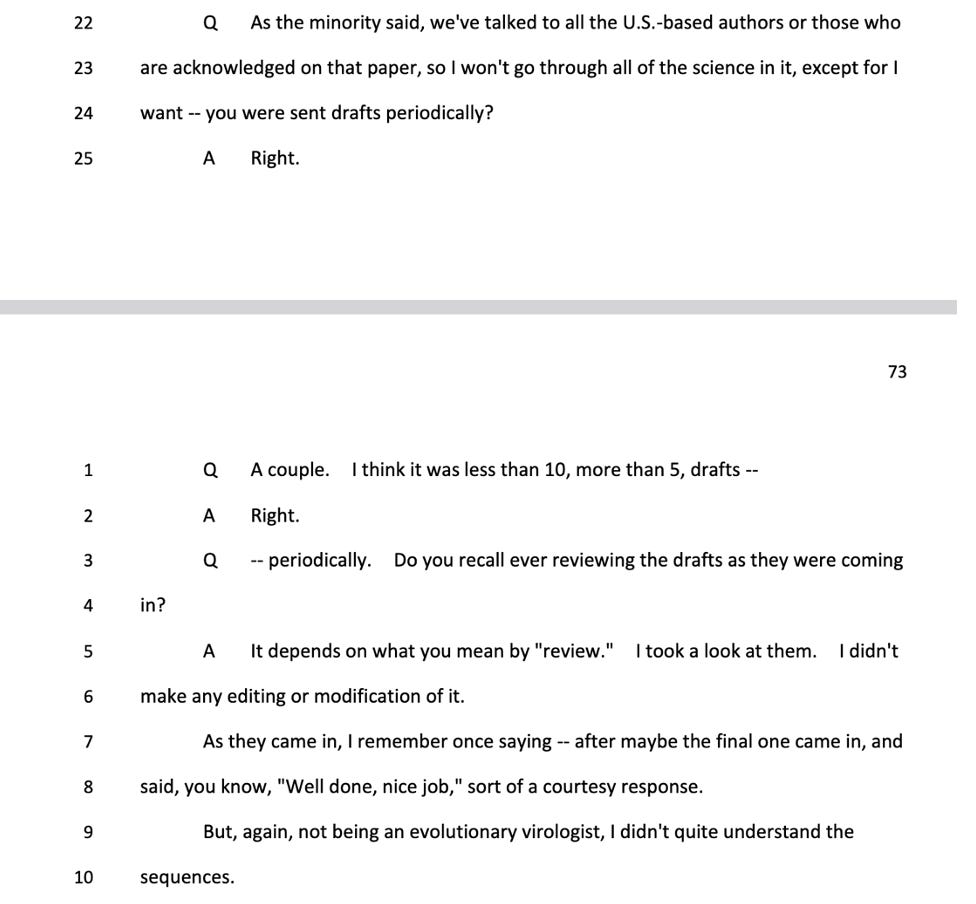
For such a politically savvy man to manipulate the scientific process directly under the nose of the President was rather unexpected. But it got worse. He also thumbed his nose at Congress.
Fauci was the darling of Republicans and Democrats, so he shocked me during a May 2021 Senate hearing when he pointed his finger at physician Senator Rand Paul and called him a liar for noting that NIAID funded dangerous gain-of-function virus research in Wuhan, China.
“Senator Paul, with all due respect, you are entirely and completely incorrect,” Fauci said while under oath. “The NIH has not ever and does not now fund gain-of-function research in the Wuhan Institute of Virology.”
In retrospect, none of this behavior should have surprised me. Fauci is highly territorial and has never allowed anyone—even the President of the United States—to mess with his fiefdom.
Pause on Fauci Science
President Obama put a pause on funding for gain-of-function research in 2014 that lasted until 2017. The gain-of-function moratorium suspended federal funding for research that enhanced the pathogenicity, transmissibility, or host range of dangerous pathogens—the exact type of research Chinese scientists had been conducting at the Wuhan Institute of Virology. This moratorium covered all types of pathogens such as influenza, MERS, and SARS viruses—the type which gave us the COVID pandemic. President Obama imposed the moratorium in 2014 after growing concerns from the scientific community and public advocacy groups about the risks associated with research and the potential for accidental release or misuse of enhanced pathogens.
The pause was triggered by a group of virologists at the Erasmus Medical Center in the Netherlands who used a gain-of-function techniques including serial passaging to adapt influenza to ferrets and made the virus airborne. The pause was lifted in 2017 after the government created a new framework to assess the dangers of gain-function research called P3CO Framework (Potential Pandemic Pathogen Care and Oversight).
But in the end, nothing really changed.
The P3CO Framework was supposed to enforce stricter oversight for high-risk virus research. I now think it was a distraction. Once P3CO was put in place, Fauci’s NIAID simply resumed funding scientists to develop bioengineered viruses. For instance, researchers used a synthetic gene library to generate all possible H5 bird flu variants capable of escaping detection by the human immune system.
I feel certain today that the moratorium was a political show that lasted just long enough for the critics to forget about the dangers of high-risk virus research that created the airborne influenza virus. NIH spent years creating the P3CO safety review, but I now realize there is a gaping hole in the very guidelines designed to check the power of funders like Fauci. A gain-of-function study was only sent for P3CO review if Fauci or his subordinates felt it needed review.
This is an obvious conflict of interest, like allowing a batter to call his own balls and strikes, while sometimes letting an umpire opine, but only if the batter permits it. Although I have no direct evidence, I am suspicious that Fauci purposely avoided sending gain-of-function projects for review to the P3CO committee.
The details of this process are very intricate and hard for outsiders to follow, but Senator Rand Paul made some of this public during an interview a year back.
We have evidence, yes, that they were dishonest, that Anthony Fauci lied in hearings to me, which is a felony, punishable up to five years. We have emails that show him saying that he knew it was gain-of-function, that the virus looked manipulated, and he was worried that this came from Wuhan lab [on] February 1 of 2020. Then he spent the last three years saying nothing to see here. We also know there was a safety committee that should have reviewed this and we know that Anthony Fauci went around the safety committee – the safety committee set up in place to make sure this didn’t happen.
After President Biden granted Fauci a preemptive pardon on his last day in office, Senator Paul sent subpoenas to get answers about what Fauci knew and when he knew it. “In the wake of Anthony Fauci’s preemptive pardon, there are still questions to be answered,” he posted on X. “Who at NIH directed funds to the Wuhan Institute of Virology, and why was the proposal not scrutinized by the P3CO safety committee?”
End Dangerous Virus Research
Throughout the COVID pandemic, concerned scientists and the general public began piecing together a troubling narrative. Emails found that the Wuhan Institute of Virology had been funded by NIAID through a subcontract to Peter Daszak’s EcoHealth Alliance. The work was ostensibly classified as viral surveillance, which allowed it to bypass the new P3CO guidelines created to rein in dangerous virus research.
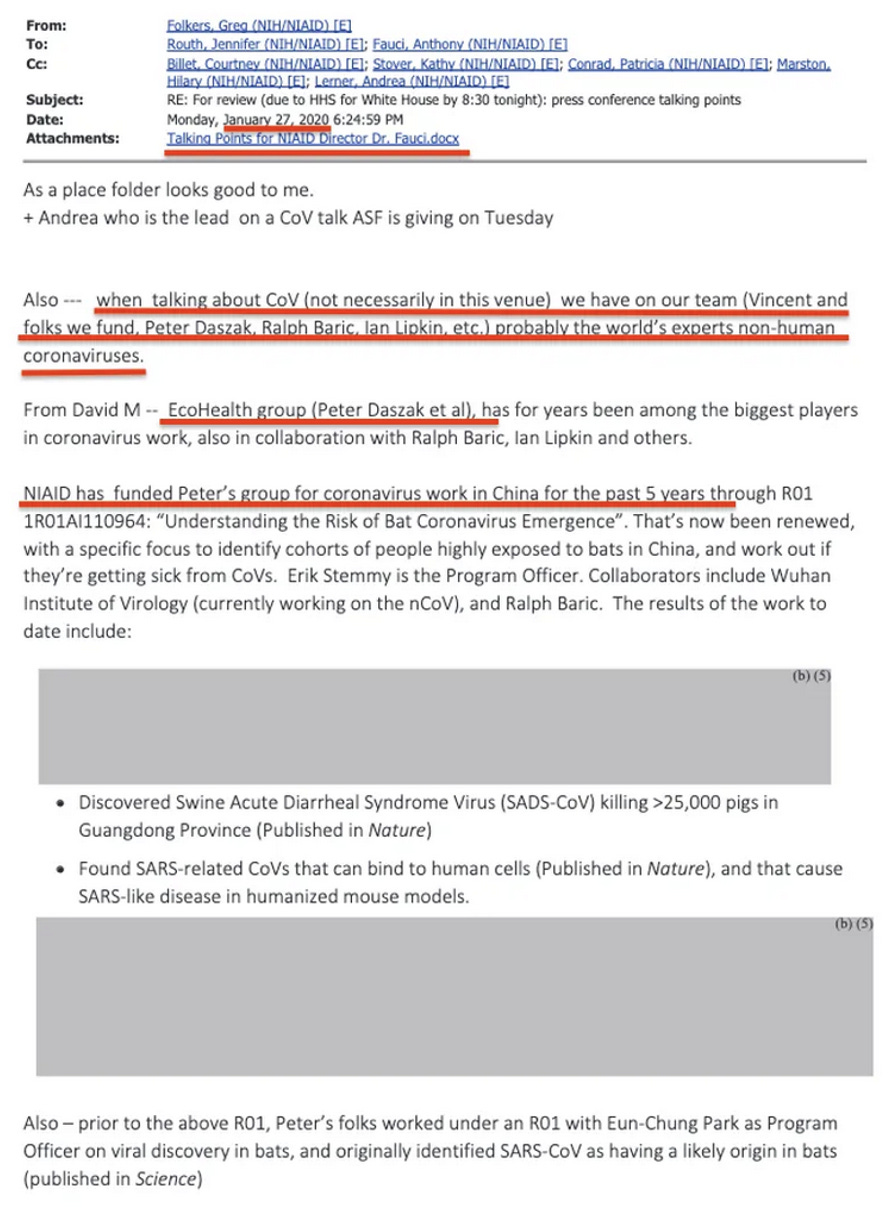
However, a closer look revealed that scientists at the Wuhan Institute of Virology led by Dr. Zhengli Shi had been trained by Dr. Ralph Baric at the University of North Carolina. Baric is widely regarded as one of the world’s leading bioengineers specializing in coronaviruses, and the NIAID had been funding him for years through a combination of grants and service contracts for pandemic preparedness. His groundbreaking work on manipulating coronaviruses (including constructing Frankenviruses) was pivotal, and that expertise had made its way to Wuhan—intentionally or otherwise.
This is an obvious conflict of interest, like allowing a batter to call his own balls and strikes, while sometimes letting an umpire opine, but only if the batter permits it.
Baric obviously has concerns about what went on in Wuhan. When a group of virologists wrote a February 2020 essay for Emerging Microbes & Infections titled, “No credible evidence supporting claims of the laboratory engineering of SARS-CoV-2” Baric made some secret changes to the text.
“Don’t want to be cited in as having commented prior to submission,” Baric emailed the essay authors, before sending in his text changes.
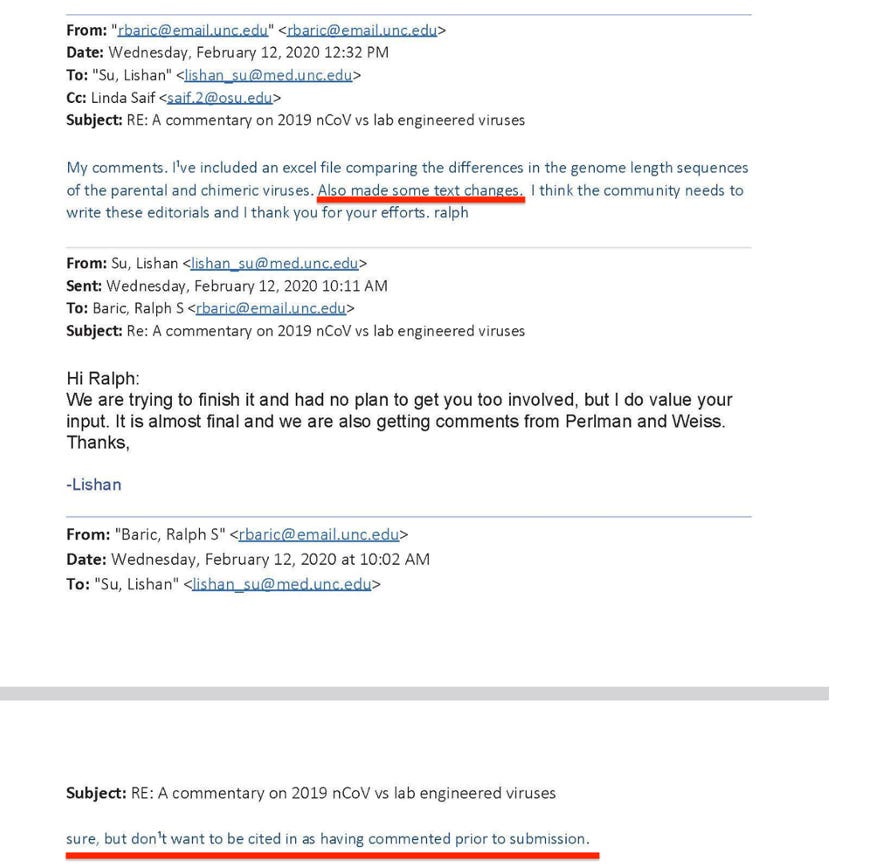
NIAID’s international cooperation efforts were rooted in the belief that building scientific capacity abroad was a global good—an ideal that often holds true. But in this case, cooperation with foreign researchers came with unintended consequences. The transfer of technical expertise and bioengineering know-how across borders, paired with inadequate oversight and misclassification of research objectives, may have created the perfect storm. While the intent may have been altruistic, the outcome was anything but.
The NIH has repeatedly demonstrated a dangerous inability to safeguard public safety. The P3CO Framework was intended to enforce stricter oversight, but proved to be a hollow safeguard, allowing NIAID to continue funding dangerous research with a fig leaf for compliance. Worse, EcoHealth Alliance’s funding of the Wuhan Institute of Virology was classified as “viral surveillance,” an administrative sleight-of-hand that enabled high-risk experiments to continue with impunity. By allowing gain-of-function research to proceed unchecked, NIH abandoned its responsibility to ensure that taxpayer-funded science did not jeopardize public health.
But NIH’s errors are not merely a matter of oversight failure—they are the result of scientific arrogance compounded by an ingrained, symbiotic relationship between federal science officers and the research academics they fund. This relationship is mutually beneficial as scientists depend on NIH funding to build their careers, while NIH officers rely on these same scientists to generate the groundbreaking studies that justify new initiatives and expand NIH’s influence.
Academic scientists and NIH bureaucrats don’t just collaborate professionally—they often emerge from the same university laboratories, attend the same conferences, and publish together in the same journals. Instead of government oversight of academic research, we have a system that rewards allegiance and mutual advancement. This cozy relationship is cemented by lavish taxpayer-funded travel to international conferences, where federal officers and the university scientists they support fly around the world, stay together at luxury hotels, and forge alliances that prioritize career advancement over public safety.
This conflict of interest is baked into the system, making genuine oversight of dangerous research nearly impossible. This is not just my professional experience, emails show this is the case. Despite public concerns about the nature of EcoHealth Alliance’s research and multiple media reports about the veracity of Peter Daszak’s public statements, the NIH program officer who oversaw EcoHealth Alliance’s grants began working directly with Daszak on his 2023 grant renewal.

Even more alarming: one of Fauci’s trusted advisors, David Morens, was caught in emails also coordinating with several academics and Daszak to get EcoHealth Alliance’ grant renewed. When Fauci testified afterwards during a congressional hearing, he claimed to barely know Morens, which is patently untrue.
NIH’s pattern of circumventing research safeguards, misrepresenting funding, and the entrenched culture of mutual dependency between program officers and academics has created a system where oversight becomes performative and regulatory frameworks like P3CO become mere window dressing. Dr. Fauci’s public denials of NIH involvement in gain-of-function research at the Wuhan Institute of Virology, despite documented evidence to the contrary, highlights a culture of obfuscation and regulatory evasion. NIH has forfeited public trust and can no longer be relied upon to serve as the gatekeeper for high-risk pathogen research.
Instead of government oversight of academic research, we have a system that rewards allegiance and mutual advancement.
The “conspiracy theory” label deployed by NIH leadership to knock down the possibility of a lab accident troubles me to this day, especially since it seems to have been a misinformation campaign. In my entire scientific career, I have never seen an alternative hypothesis shot down by labeling it a “conspiracy theory.” This was something completely foreign to me, a shameful example of McCarthyism in the scientific community, and the very antithesis of science.
To prevent future disasters, gain-of-function virus research should end at the NIH and should not be funded by any federal agency. Moreover, the government needs to assume legal authority to prevent gain-of-function virus research at private companies or institutions as well. High-risk research that involves manipulating pathogens capable of causing global pandemics should not be treated as routine biomedical research—it should be viewed as having the same risk as bioweapons development.
Despite its defenders, gain-of-function research has not demonstrably contributed to the prevention of pandemics. Let’s not forget, the COVID pandemic started in Wuhan, China, a city that hosts a research lab that is supposed to stop pandemics. The time has come to abandon the false promise that we can outwit nature by engineering lab viruses. We need to shift research to rapid identification of emerging pathogens when they cause symptoms in humans and domesticated animals, and funding should be redirected toward safer, more responsible methodologies such as structural and computational modeling, and laboratory techniques like deep mutational scanning, and loss-of-function studies.
These approaches can help us understand how viruses jump from animals to humans without making these same pathogens more dangerous. For too many years, scientists have sold the public on a lie. It is time to realign our research priorities with the principle that science should serve public safety and protect lives—not gamble with them.


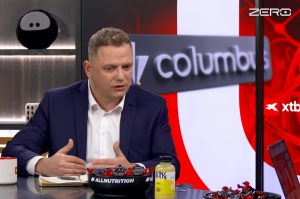
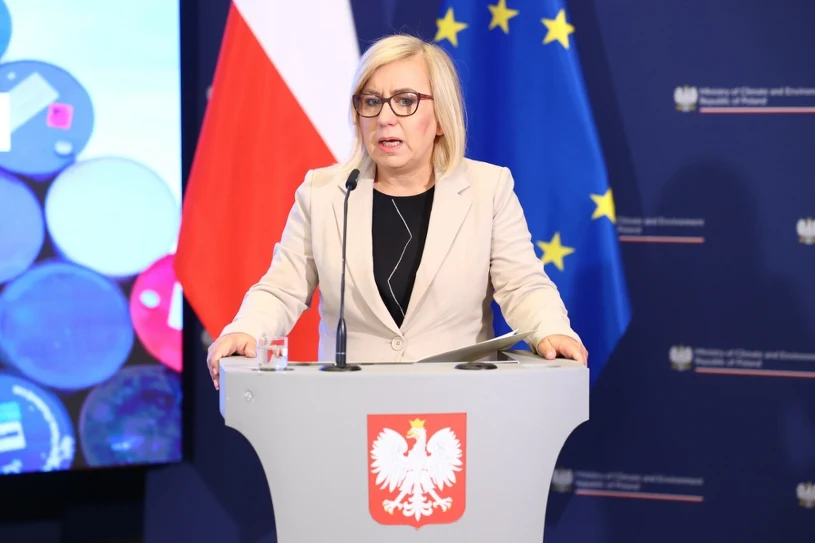


![Ceny bydła przed Świętami. Sprawdziliśmy stawki w skupach [SONDA]](https://static.tygodnik-rolniczy.pl/images/2025/12/16/591782.webp)
